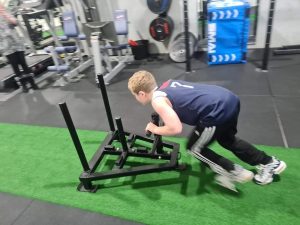Phoebe Alexander is a local physiotherapist and owner of Coast Movement Physio, a mobile service for kids and adults with disability. Having worked with kids for 10 years, Phoebe has dropped in to clear up some myths surrounding paediatric strength training and offers some advice for introducing your children to this. If you are thinking her name sounds familiar, that is because she is married to Physio Connex physio Andrew; although don’t hold that against her!
Strength training is becoming an integral part of physical education classes, sport training and youth fitness programs and as a result, I often get asked by parents if strength training is safe for kids. The short answer is a resounding yes, it is absolutely safe. In fact, there are many benefits of strength training; from improvements in health and fitness, to physical literacy and even injury reduction. However, as with any sport or fitness training for your child, there are things to be mindful of, and guidelines to follow.
Strength or resistance training are terms used to describe a component of training that is designed to improve muscle strength, power and endurance. Often, strength training is associated with using free weights such as dumbbells, and weight machines. It also encompasses a wide range of resistance loads including medicine balls, kettlebells, barbells, resistance bands, and a person’s own body weight. All are safe for children to use, when supervised and prescribed appropriately.
So what are the recommendations and what are the risks and contraindications?
Current Australian Strength and Conditioning Association (ASCA) recommendations:
What age can a child start strength training?
Once a child is ready to participate in organised and structured sports such as soccer, basketball, cricket etc, then they are generally ready to perform a supervised training program. As long as a child has the capacity to follow clear directions, and can understand basic safety instructions, they are safe to commence strength training. It is the position of ASCA that the youngest a child could begin resistance training, is six years of age – emphasising that programs need to be supervised and facilitated in a safe environment. Most gyms in Australia will have an age limit much older than this but when programmed and supervised by a health professional this can be done so safely in their clinics or performance gyms.
It is important to stress that each child is different, and clear goals should be set when commencing a strength training program.
How much weight is safe?
The current guidelines are pretty clear around how much resistance should be applied.
“Preadolescence and adolescence should avoid competitive weight lifting, power lifting, body building and maximal lifts until they reach physical and skeletal maturity.” (ASCA 2017).
A child or youth should be able to perform 8-15 successive repetitions in good form before increasing weight or resistance. Depending on the goals of the training program (i.e. strength versus endurance), 1 to 3 sets of 6 to 15 reps performed on 2 or 3 non-consecutive days a week is recommended.
What is a safe training intensity?
Once again, this should be specific to the child and their goals. The current recommendations are that children 6-9 years of age should perform body-weight and light resistance (bands, broomsticks etc.) for high repetitions. Children 9-12 years of age should aim for 10-15 of their repetition max, with maximal loading of 60%. Children aged 12-15 should aim for 8-15 of their repetition max at 70% max loading, and youth aged 15-18 years should be aiming for 6-15 repetition max at 80% max loading.
For all of the above recommendations, it is of utmost importance that the child has direct supervision and is coached on correct form and technique. If this does not occur, the child is at risk of injury.
Injury is one of the main concerns raised by parents when discussing strength training and children. There are a lot of myths about injury to skeletal development and paediatric strength training and although most of these are incorrect, the following groups of children may be at greater risk of injury, or contraindicated:
- Children/youth who are unable to follow direct instruction and have basic knowledge and understanding of safety.
- Children/youth with the following medical conditions; hypertrophic cardiomyopathy, pulmonary hypertension, Marfan Syndrome, or individuals who have been treated with anthracycline chemotherapy.
If your child is interested in strength training, or you feel it may be of benefit to them, get in touch with your Physiotherapist or accredited Strength and Conditioning Coach today to discuss your options. If your child requires specialised disability services, please contact Phoebe at Coast Movement Physio to organise an onsite consultation and access to our gym at Physio Connex.




